Compared to the departing stellar canopy of winter, at first glance the spring sky may seem rather less inspiring. Yet, appearances can be deceptive and there is much to wonder at amongst the constellations now arranged across the south and east.
Our tour commences as darkness falls around 21:45h. By then Leo, the most readily identifiable spring constellation is located due south. The head and mane of the lion is marked by the distinctive star asterism known as the ‘sickle’, although some people view it as a backwards question mark. At the base of this arrangement shines prominent Regulus, Leo’s chief star, and faintest of the 1st magnitude stars. Regulus sits just above the ecliptic and as a consequence is sometimes occulted by the Moon and on very rare occasions by a planet.
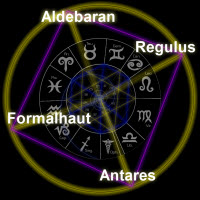
"Royal Stars of Persia"
Aldebaran (Taurus): Vernal equinox
Regulus (Leo): Summer solstice
Antares (Scorpio): Autumnal equinox
Fomalhaut (Aquarius): Winter solstice
In antiquity; from 4000 to 2000 BC Regulus was counted as one of the four Royal stars, those bright stars closest to the equinox and solstice positions. During this period Regulus was nearest the summer solstice position, but the effect of precession has subsequently shifted this point well away.
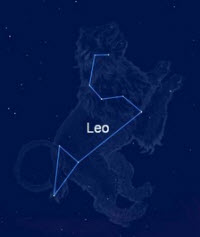
Constellation: Leo
To the left of the sickle, a ‘triangle’ of stars depicts the hindquarters of Leo. Just beneath an imaginary line joining Regulus to Denebola, the rearmost star of this triangle, a number of galaxies are found, some of which are visible under good seeing conditions in smaller scopes (see chart).
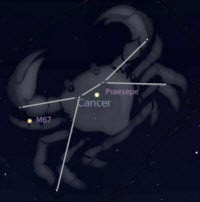
Constellation: Cancer
Ahead of Leo scuttles Cancer, faintest of the zodiac constellations the stars of which are often drowned out by moonlight or light pollution. Cancer is home to the fine open cluster M44 or Beehive, sometimes known as the Praesepe; ‘the ‘manger’. To the naked eye it appears as a misty patch, but a small scope reveals many individual stars.
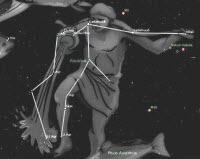
Constellation: Hydra
Our next destination, Hydra – Water Serpent, is the largest constellation in the heavens, extending from below Cancer in the WSW, to beneath Virgo down in the ESE. Indeed it is well after 11pm before the entire constellation is visible. Hydra’s brightest star; Alphard- the ‘solitary one’, is located a hands span to the southeast of the distinctive, though rather faint, loop of stars marking the beasts writhing heads, visible to the right of Regulus.
In Greek mythology Leo, Cancer and Hydra are all associated with Hera, Queen of the gods. Both Leo and Hydra were raised as pets by Hera. Leo’s coat was said to be impervious to fire and metal weapons, whilst the multi-headed snake was empowered with the ability to re-grow heads should one be cut off. In the first of his twelve labours, Hercules, whom Hera despised, was tasked with slaying the lion beast ravaging the region of Nemea. He duly trapped the beast in a cave and clubbed it to death. In honour of this deed, Zeus placed the lion in the heavens.
Decidedly miffed by the loss of her pet, Hera then pitted Hercules against the multi headed Hydra, which he overcame by using flaming arrows to cauterise the neck-stumps thus stopping the heads from regenerating. Hera; who saw the snake was in trouble, sent a giant crab (Cancer) to assist Hydra. In the ensuing battle Hercules also crushed the giant crustacean. A distraught Hera then placed both monstrous creatures in the heavens.
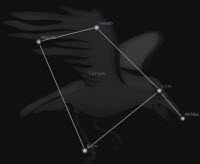
Constellation: Corvus
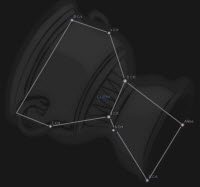
Constellation: Crater
Toward the tail of Hydra, two small but original constellations rest on snakes body; Corvus the Crow and Crater the Cup. The outline of Crater is rather faint and therefore difficult to trace in light polluted skies. Corvus is more prominent; a quadrilateral grouping of stars that, mariners and astronomers alike refer to as ‘Spica’s Spanker’, a spanker being a type of sail nearby the bright star Spica.
Corvus and Crater are linked by one legend in which Apollo sent his pet white crow to fetch a cup of water. The bird flew off with the cup in his talons, but tarried, waiting for the fruit of a fig tree to ripen. On his return Corvus tried to convince Apollo that Hydra the water snake had delayed him. Apollo did not believe the bird and in a rage turned the crow black, dispatching him to the sky close to Crater, which is just out of the thirsty bird’s reach.
- Log in to post comments

